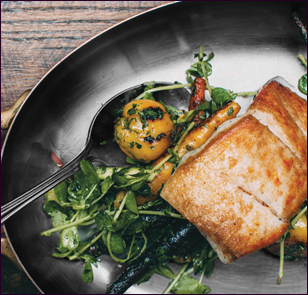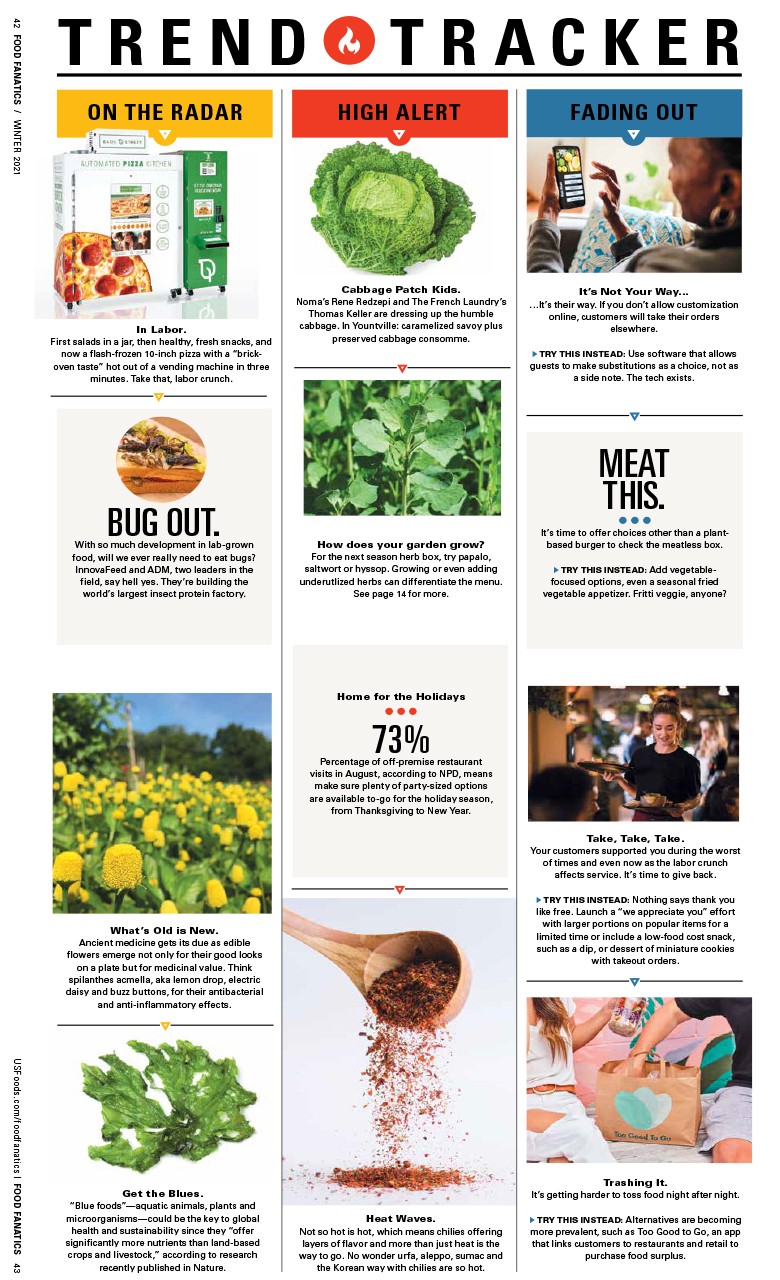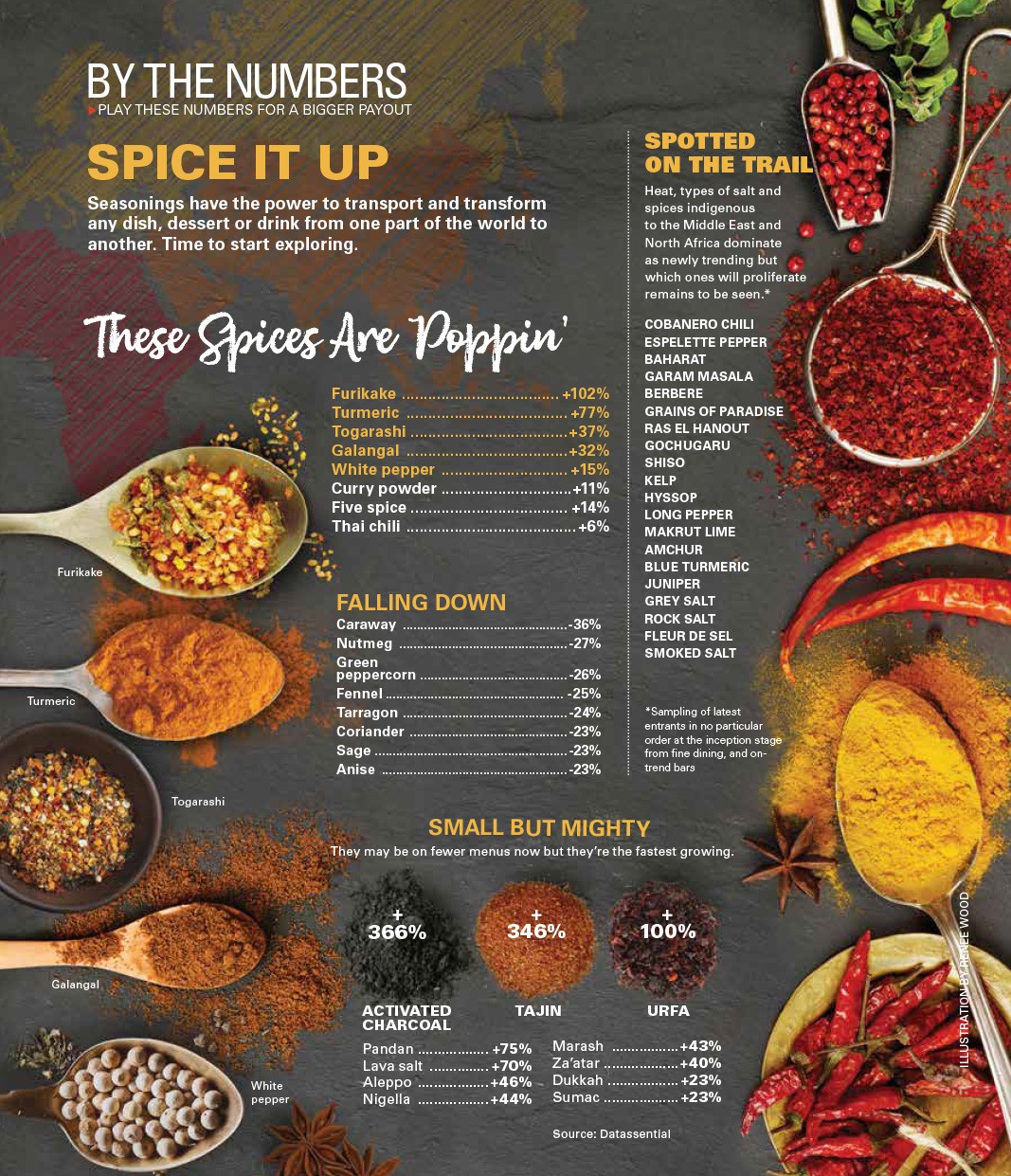Special Section: Fin It To Win It
Get diners hooked on seasonal and lesser-known fish.
SPECIAL SECTION SPONSORED BY BEAVER STREET FISHERIES, INC
A walk through the farmers market reveals stalls overflowing with fire-hued squashes, hearty greens and apples galore. Fall is definitely here. But at fish-focused restaurants, shifting seasons affect more than the produce chefs put on the plate.
“People know that Alaska salmon and soft-shell crabs are seasonal, but they don’t necessarily know that most every fish has a peak season,” says Mark Grosz, chef-owner at Oceanique in Evanston, Illinois. “The quality, the price and the flavor are all better.”
As seafood prices continue to rise, chefs can help reduce overall food costs by incorporating lesser-known fish, which tend to be less expensive. And thanks to a growing interest in sustainable dining, consumers will find much to love in seasonal offerings featuring these underwater underdogs.
Running with the Season
Because diners look forward to salmon season year after year, Executive Chef Duncan Biddulph of Chicago's Kinmontfeatures the fish as the classic “Catch of the Day” during those months along with walleye and trout. To allow seasonal catches to shine, he gives them little enhancement. Each one is simply prepared with brown butter and lemon or extra-virgin olive oil, lemon, parsley and butter.
Since the options change frequently and many fish aren’t available year-round, chefs and restaurants are stoking anticipation and keeping guests informed when seasonal fish are on the menu. Many use social media to share news of deliveries, recipe development sessions, menu updates and specials.Chef-partner Giuseppe Tentori at GT Fish & Oyster in Chicago uses Twitter and Instagram to post pictures of his latest acquisitions and newest dishes. “The response is instantaneous,” he says. “It helps people getexcited for the season’s catch.”
A Fresh Perspective
Sustainability isn’t simply about avoiding species flagged as overfished by watchdog groups. To help change diners’ preferences and behaviors, chefs are offering lesser-known varieties from robust populations.
At Fiola Mare on the Georgetown waterfront in Washington, D.C., Chef-owner Fabio Trabocchi showcases wild-caught American sturgeon. Pan roasted with bay leaves, a medallion of the steak-like fish arrives with a crispy cardamom seed tuile, red wine and port reduction, and light foie gras mousse.
Just a few miles away, Executive Chef Michael Huss enjoys introducing diners to tautog at BlackSalt. “It has a light and sweet flesh that tastes reminiscent of the crabs and shellfish that the fish feeds on,” he says. In the fall, tautog is simply pan seared and presented on top of a chowder rich with littleneck clams, Virginia ham and seasonal root vegetables, like potatoes and parsnips.
Check Your Backyard
The availability of certain fish can fluctuate as frequently as the menu, leading some chefs to emphasize local. Executive Chef-owner Cory Bahr only features fish caught in the Gulf at Restaurant Cottonin Monroe, Louisiana. Seasonal dishes like pan-roasted black drum with whipped cauliflower and grilled amberjack with ham hock butter take center stage. “I don’t need to reach across the globe when there are beautiful fish in my backyard that help support my local fisherman,” he says.
At Charlie Bird in New York, Chef-owner Ryan Hardy restricts himself to catches made on the Eastern Seaboard. “We want to celebrate the greater area we live in,” he says. “People sometimes forget that Manhattan is an island in the middle of the Atlantic.”
Waste Nothing
No matter what philosophies guide the acquisition of fish, every chef wants to make the most of the product. A growing number of chefs are finding uses for everything from tip to tail.
“No part of the fish goes to waste if we can help it,” says Chef-owner Jeff Tunks of Passion Food Hospitality, a restaurant group that includes the seafood-centric PassionFish in Reston, Virginia. Scraped bits of salmon go into sushi rolls and seafood Cobb salad, while crisped Arctic char skin is served as a crunchy garnish on several dishes and hamachi collars are served as specials.
“No part of the fish goes to waste if we can help it."
-Chef-owner Jeff Tunks of Passion Food Hospitality
Discarded parts and organs become tools of creativity at restaurants across the country. Bahr serves cornmeal-fried snapper throats at Restaurant Cotton. Louisville, Kentucky’s Seviche has featured pan-roasted golden tilefish cheeks with jalapeño-lemon beurre blanc. Meanwhile, monkfish scraps and organs are transformed into crostini topping at Charlie Bird.
Tentori serves crispy seabream fish heads as a complimentary treat for VIPs. Once the gills and scales are removed, the fish heads are tossed in rice flour, deep-fried and coated with plum-ginger sauce. “They’re a little scary because they’ve got the teeth and the eyes popping out,” he says, “But people really appreciate them. They taste a little bit like potato chips.”
One Man’s Trash Fish …
When a new species arrives in the kitchen, chefs take a visceral approach to preparing it. “You break it down, nibble on it and see what it’s like in the mouth,” Hardy says. A simple pan roast or quick grill reveals how its textural consistency and flavors evolve when cooked. Then there are other practical considerations: Should it be served whole or filleted? How about raw? Skin on or skin off? Do some or all of the bones need to be removed? What accompaniments will best accentuate its natural flavor?
Many of these relatively unknown fish are known as “bycatch,” “incidental catch,” “rough fish” or “trash fish.” These species are accidentally harvested while fishermen are targeting more desirable species.
To celebrate these under-the-radar catches, Nico Romo, culinary executive director at Fish in Charleston, South Carolina, recently hosted a “Trash Fish” dinner. “The idea is to use fish that people don’t know about,” he says. In fact, many of today’s most popular fish, including escolar and mahi-mahi, were considered undesirable bycatch before chefs realized their potential on the plate.
Triggerfish, for example, is a trash fish making waves today. At Seviche, triggerfish is starring as ceviche, pepped with yuzu, jalapeño and apple. At The Lazy Goat in Greenville, South Carolina, triggerfish is served “on the half shell.” With skin left on one side, the fish is brushed with a mixture of lemon juice, olive oil and sea salt. After a quick grilling, it’s plated with peas, Ruby Queen turnips and roasted tomatoes. At Yakko-San in North Miami Beach, Florida, triggerfish flesh is dried into salty, chewy strips of jerky.
Convincing guests to try an unfamiliar fish for the first time can be challenging. To really win them over, woo your front line of service. “Your servers are the ambassadors of your restaurant,” Tunks says, “so you have to get them excited and informed. If they can pass that knowledge and enthusiasm on to the guests, you can make any fish dish a star.”
Nevin Martell is a Washington, D.C.-based freelance food and travel writer.
Meet The Rising StarsThink outside the tackle box and consider these lesser-known, sustainably sourced species angling to become diners’ new favorite fish: Snakehead » Despite its fearsome face and off-putting name, this invasive species from Asia succeeds in almost any preparation and tastes like chicken when cooked. Golden Tilefish » Populations of the rainbow-hued fish are robust in the mid-Atlantic, but avoid those sourced elsewhere. Its mild flavor—not unlike lobster or crab—is best showcased by grilling or pan roasting. Wreckfish » This bass-like saltwater fish is found off the coast of South Carolina. Its flaky, firm meat with a grouper-esque flavor works well in a variety of preparations. Pomfret » Alternately known as monchong, this Hawaiian fish has firm, clear flesh that turns white when cooked. Due to its high oil content, pomfret is great for grilling. Red Drum » Similar to red snapper, its meat possesses a sweet, mild flavor. Bake, broil, grill or saute this Gulf favorite, but avoid raw preparations. |




